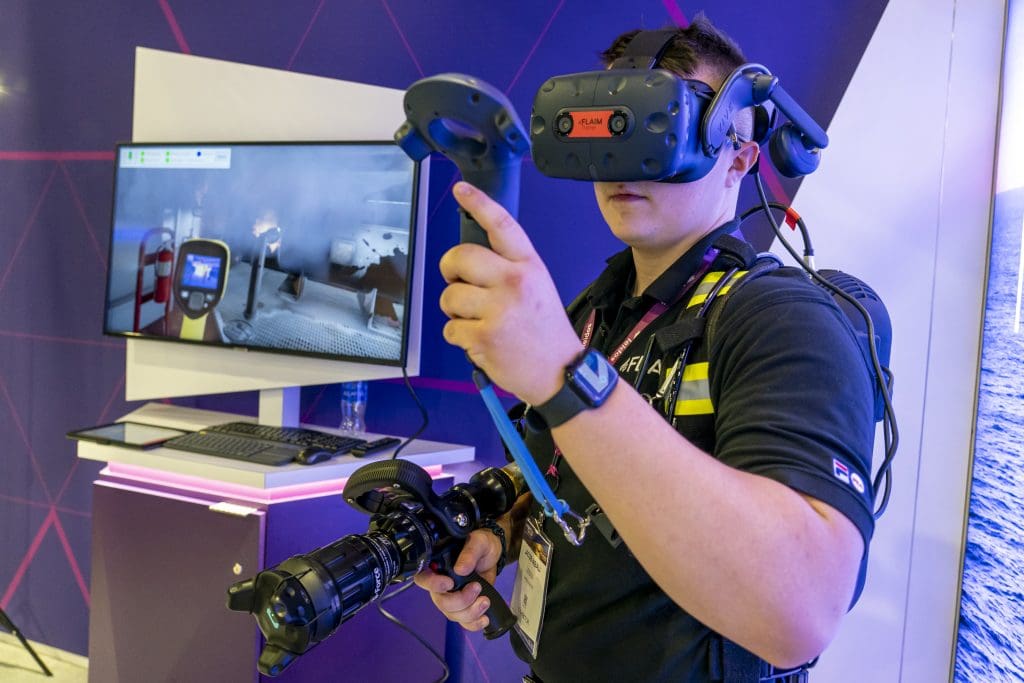This article was written by Dr James Mullins and originally appeared in Asia Pacific Fire Magazine on January, 2023. It can be viewed here.
Under the apprenticeship model of fire service learning, skilled instructors traditionally guide students through a series of increasingly more complex scenarios with the aim of developing muscle memory and improving skills retention.
This method of learning requires that trainees access realistic training grounds, often necessitating significant travel and logistical challenges backfilling response capability. As a result, on average in Australia, firefighters are limited in their access to live-fire training facilities with an average duration between events exceeding two years.1
Training delivery has changed over the past several decades. My early fire service training started much like my university degree: blackboards, overhead transparencies, VHS tapes and practical training drills. Over the years we’ve progressed to whiteboards, data projectors and eLearning – but the old adage of ‘the two things firefighters hate are change and the way things are’ remains the same. As we move to adopt new technologies in place of tradition, we will always experience pushback from within – but in a highly regulated industry, providing the ability to make data-driven decisions is critical for management to enact change and be confident in the outcomes.
We should not look to new technology to replace traditional training methodologies, rather we should augment it. Immersive learning is not new. In 1929 the first commercial flight simulators were introduced with much of the aviation industry dismissing them as a fad. Now, pilots can gain type certification in aircraft and the first time they will fly will be in the real aircraft, sometimes even as the lone occupant. Our military has been using immersive training tools for decades to train our soldiers how to shoot, our generals to employ tactics and our sailors how to deal with simulated adversaries under the waves.
One of the benefits of computer-based simulation systems is the ability to repeatably create environments that are difficult, dangerous or expensive. Whilst all our traditional training could be considered a simulation – for example, gas-fired props, burning OSB in a CFBT container or even a controlled acquired structure – we have challenges creating realism safely. How do we accurately simulate structural collapse or flashover? How do we simulate large-scale high-risk, low-incidence scenarios? In the United States, nearly 100 firefighters have died on the training ground in the past 10 years. Whilst around 60% were cardiac-related health issues, around 40 fatalities were reported due to what essentially equates to a failure to adequately prepare our people safely for the ultimate test of our capabilities and equipment, the live fire burn.
In 2022, the World Health Organisation declared firefighting as a cancer-causing profession. Carcinogenic exposure due to by-products of combustion, exposure to firefighting foam, and environmental discharge regulations all mean less exposure to hot-fire burns. With the number of fires occurring operationally decreasing, more and more firefighters are receiving minimal on-the-job hot-fire experience.
Immersive learning allows our firefighters to experience a number of complex and challenging environments safely. It allows our firefighters and officers to make mistakes, learn from them and develop skillsets that are transferable into the live-fire training ground and ultimately into real events.
Using data to make intelligent decisions is critical for any forward-looking fire service. Traditionally, reporting has been handled at the instructor level by observing the behaviour of an individual and subjectively determining if he or she is meeting the standards set by the organisation. Impeding this is individual bias, access to consistent fire behaviour or the ability to record accurately as often the instructor is wearing breathing apparatus and gloves and is assessing a larger cohort on the training ground. The ability to back-up experience with hard facts in an era of increased regulatory compliance and reporting is essential – and is a common pain point in most fire services today.

Regulatory bodies are placing increased pressure on fire services to comply with and deliver training against often complex and difficult-to-navigate standards. Risk and compliance require proof of an individual’s ability at the time of assessment to meet these standards and traditional learning management systems are often limited to providing simple pass/fail assessment outcomes. Immersive learning technologies allow trainees to perform their training in a controlled, repeatable environment and simultaneously capture hundreds or thousands of micro events combining to represent elements of a unit of assessment.
By mapping these micro events against a PUA standard, curriculum designers and assessors can capture and prove an individual’s compliance against a standard. These standards often require a student to demonstrate a skillset at least three times over a variety of scenarios – something immersive virtual learning environments are tailor-made for.
Once data is captured, it can be used to understand a cohort’s ability to move on their journey towards the hot-fire training ground, additional classroom-based learning or further immersive learning. Data can be evaluated based on demographic, life experience, number of iterations or biometric stress factors, giving senior management a traffic-light system of the capability of their workforce to safely execute their training, providing rich feedback to the individual on areas of improvement against organisational operating procedures, or sending links to further learning directly to email inboxes within seconds of a training scenario being completed.
Immersive learning technology is not designed to replace traditional training. It is used as a tool to help identify and reduce skills fade in an organisation and to provide an evidence-based, consistent reporting mechanism to senior management.
For more information, go to flaimsystems.com
References
1. Survey of FLAIM Systems fire services customers conducted in June 2022